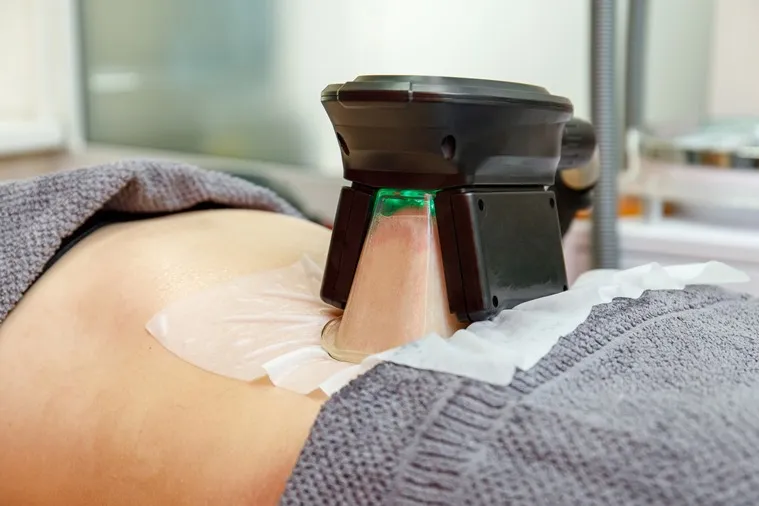Health
Comprehensive Guide to Fat Freezing Overview
Published
4 months agoon

Fat freezing, scientifically known as cryolipolysis, is a popular non-surgical method for reducing localized fat deposits that are resistant to diet and exercise. This guide delves into the details of the procedure, its benefits, risks, and what to expect.
Background
The technique of fat freezing is based on the observation that fat cells are particularly vulnerable to cold temperatures. This method was commercialized in 2010 when the FDA approved CoolSculpting, a leading brand in the industry.
How Cryolipolysis Works
Cryolipolysis leverages the fact that fat cells freeze at higher temperatures than other types of cells. When exposed to controlled cooling, these fat cells crystallize and die. The body then naturally processes and eliminates these dead cells over time.
Procedure Breakdown
- Application: A device equipped with cooling panels is positioned on the targeted area.
- Cooling: The area is cooled to a temperature that freezes fat cells without damaging surrounding tissues.
- Aftercare: The body gradually flushes out the dead fat cells over the following weeks.
Ideal Treatment Areas
Fat freezing can effectively target areas including:
- Fat freezing Abdomen
- Fat freezing Love handles
- Thighs
- Back
- Chin area
- Upper arms
- Bra line
- Buttocks
Treatment Process
- Initial Consultation: A certified specialist evaluates the patient’s suitability for the procedure.
- Preparation: The target area is marked, and a protective gel pad is applied.
- Cooling Session: Each treatment session lasts between 35 to 60 minutes per area.
- Post-Procedure Massage: This helps to break down the frozen fat cells and enhance results.
Advantages of Fat Freezing
- Non-Surgical: No need for incisions, anesthesia, or recovery time.
- Specific Targeting: Addresses fat deposits in designated areas.
- Gradual Results: The reduction of fat occurs gradually over 1-3 months, providing natural-looking results.
- Permanent Fat Loss: Once destroyed, fat cells do not regenerate.
Common Side Effects
Patients may experience temporary side effects such as:
- Redness
- Swelling
- Bruising
- Tingling or numbness
- Mild discomfort
Risks and Precautions
While generally safe, cryolipolysis is not suitable for everyone. Rare risks include paradoxical adipose hyperplasia (an increase in fat cells) and skin sensitivity issues.
Expected Outcomes
- Timing: Initial changes can be seen in three weeks, with full results in two to three months.
- Effectiveness: Treatment can result in up to a 25% reduction of fat in the treated areas.
Cost Considerations
The price of fat freezing varies depending on the number of areas treated and location, typically ranging from $600 to $1,500 per session.
Selecting a Provider
- Qualifications: Ensure the practitioner is certified and experienced.
- Facility Standards: The clinic should use FDA-approved equipment.
- Reviews and Results: Look for positive reviews and before-and-after photos to gauge effectiveness.
Aftercare Tips
- Normal Activities: Patients can resume their usual activities immediately after treatment.
- Hydration: Drinking plenty of water aids in the elimination of fat cells.
- Healthy Habits: Maintaining a balanced diet and regular exercise helps to sustain the results.
Comparing Alternatives
- Liposuction: More invasive, with a greater capacity for fat removal.
- Laser Lipolysis: Uses laser energy to melt fat, less effective for larger areas.
- Ultrasound Fat Reduction: Employs sound waves, offering similar effectiveness with different technology.
Conclusion
Fat freezing offers a cutting-edge solution for those seeking to reduce stubborn fat without surgery. This guide aims to provide a thorough understanding to help you decide if cryolipolysis aligns with your body contouring goals.
Additional Information
- For more details, visit the official CoolSculpting website and other reputable providers.
- Schedule a consultation with a certified specialist to discuss your specific needs and treatment options.
Recent News


Instagram Story Viewer: Shaping Social Media!
Could you think of Instagram without stories? Even though Instagram Stories were introduced not so long ago, in 2016, they...


Top Benefits of Using a Phone Appending Platform for Batch Data Updates
In the world of data-driven marketing, having access to accurate and current contact information is essential for successful customer outreach....


3 Tips for Dressing Perfectly for Special Occasions
Dressing for special occasions can sometimes be a stressful and overwhelming process, especially for women. Whether you’re attending a wedding,...


Maximise Your Hunting Success with Dive Bomb Industries Decoys
When it comes to hunting, there’s no such thing as too much preparation. Hunters understand that the right equipment can...


Castle App Free Download — Updated 2024 Version
What is Castle App? Castle App, a stream app developed for streaming media content, makes entertainment effortless by giving clients...


How to get a duplicate RC book for your vehicle: A step-by-step guide
If you have lost or damaged your vehicle’s registration certificate, you must be tense and under stress. But getting a...


Enhancing Property Value Through Professional Builders Cleaning Services in the UK
Construction and renovation projects make a ton of residue, garbage, and soil, passing on a requirement for proficient cleaning to...


Saturn in Sidereal Pisces-March 28,2024 to February 21st 2028 by Jade Luna
I really wanted a female president governing this cycle but the chart of America would choose the hardest path, not...


Top 5 Super Clone Rolex for Women
Super clone Rolex watches are incredibly detailed knock-offs of popular Rolex models, crafted to look and feel just like the...


Transforming Dreams into Reality: A Success Story of Purchase Amazon Seller Account
Purchase Amazon Seller Account: In the fast-paced world of e-commerce, many aspiring entrepreneurs dream of starting their own business. However,...
